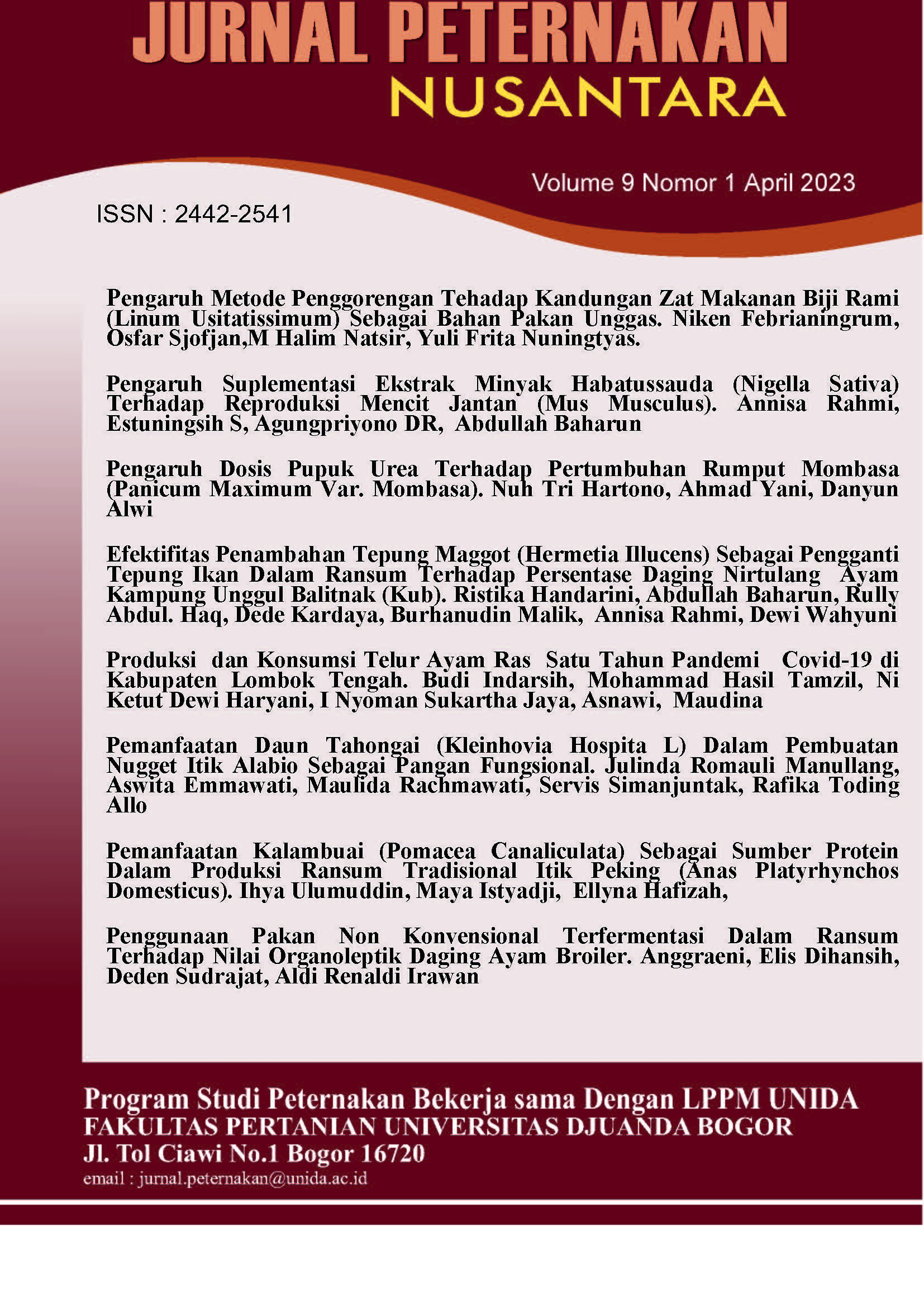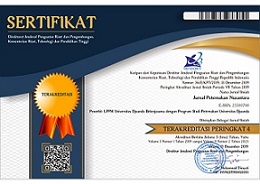PENGARUH METODE PENGGORENGAN TEHADAP KANDUNGAN ZAT MAKANAN BIJI RAMI (LINUM USITATISSIMUM) SEBAGAI BAHAN PAKAN UNGGAS
EFFECT OF FRYING METHOD ON NUTRITION CONTENT OF FLAXSEED (LINUM USITATISSIMUM) AS A POULTRY FEED
DOI:
https://doi.org/10.30997/jpn.v9i1.5533Keywords:
Linum usitatissimum, flaxseed, penggorengan, sangrai, proksimat, asam fitat, tanninAbstract
Linum usitatissimum is one of feed ingredients with high protein from the Cerealia group, so it is very potential to be used for bran substitution alternative, but flaxseed contain several antinutrients, like Phytic acid and tannin, it can cause disrupt metabolism and productivity of livestock, so it’s can be reduced by heating with the frying method. The purpose of this research was to determine the effect of frying variance on the nutritional content and antinutrient of flaxseed as a feed due to the treatment given. The analysis used is Analysis of Variance (ANOVA) in Completely Randomized Design (CRD). The results showed that the treatment was able to give a very significant effect (P<0.01) on the content of dry matter, ash, crude protein, crude fiber, crude fat, gross energy, ADF, NDF, as well as anti-nutritional phytic acid and tannins. The frying treatment reduced the dry matter content by 94.99±0.07a, ash 2.93±0.01a, crude protein 20.48±0.07a, crude fat 27.10±0.02a, gross energy 5919.65±10.61a, ADF as much as 27.36±0.05a, NDF as much as 37.22±0.07a, as well as anti-nutritional phytic acid as much as 37.03±0.03a and tannin as much as 1.99±0.0014a, but increased the crude fiber as much as 15.84±0.01d. The best linseed roasted is roasted frying used sand as media with 10 minutes.
Downloads
References
Alyani F, Ma’ruf WF, Anggo AD. 2016. Pengaruh Lama Perebusan Ikan Bandeng (Chanos chanos Forsk) Pindang Goreng Terhadap Kandungan Lisin dan Protein Terlarut. Jurnal Pengolahan dan Bioteknologi Hasil Perikanan. 5(1): 12-22.
Badan Pusat Statistika. 2020. Produksi Daging Ayam Ras Pedaging pada Tahun 2018-2020. https://www.bps.go.id/indicator/24/488/1/produksi-daging-ayam-ras-pedaging-menurut-provinsi.html diakses pada tanggal 8 Agustus 2021.
Badan Standarisasi Nasional. 2015. Pakan Ayam Ras Pedaging (Broiler)-Bagian 3: Masa Akhir (Finisher). SNI Nomor 8173.3:2015. Badan Standarisasi Nasional. Jakarta.
Ganorkar PM, Jain RK. 2013. Flaxseed--A Nutritional Punch. International Food Research Journal. 20(2): 519-525.
Isharyudono K, Mar’ah I, Jufriyah. 2019. Penggunaan Bahan Inkonvensional Sebagai Sumber Bahan Pakan. Jurnal Pengelolaan Laboratorium Pendidikan. 1(1): 1-6.
Jamaluddin P. 2018. Perpindahan Panas dan Massa pada Penyangraian dan Penggorengan Bahan Pangan. Makassar: Badan Penerbit Universitas Negeri Makassar.
Kajla P, Alka S, Dev RS. 2014. Flaxseed a Potential Functional Food Source. Journal Food Sciences Technology. 1-15.
Ly J, Sjofjan O, Djunaidi IH, Suyadi. 2017. Effect of Processing Methods on Nutrien and Tannin Content of Tamarind Seeds. Tropical Drylands. 1(2): 78-82.
Orthoefer FT, Gary RL. 2007. Evaluation of Used Frying Oil. 329-342.
Prawitasari RH, Ismadi VDYB, Estiningdriati I. 2012. Kecernaan Protein Kasar dan Serat Kasar Serta Laju Digesta pada Ayam Arab yang Diberi Ransum dengan Berbagai Level Azolla microphylla. Animal Agriculture Journal. 1(1): 471-483.
Putra EA. 2019. Pengaruh Perbedaan Proses Penggorengan Terhadap Kandungan Anti Nutrisi dan Zat Makanan Biji Asam (Tamarindus indica L.) Sebagai Bahan Pakan Unggas. [Skripsi]. Fakultas Peternakan Universitas Brawijaya. Malang.
Rosiani N, Basito, Esti W. 2015. Kajian Karakteristik Sensoris Fisik dan Kimia Kerupuk Fortifikasi Daging Lidah Buaya (Aloe vera) dengan Metode Pemanggangan Menggunakan Microwave. Jurnal Teknologi Hasil Pertanian. 8(2): 84-98.
Siswantoro B, Rahardjo N. Bintoro, Hastuti P. 2012. Pemodelan Matematik Pindah Panas dan Massa Pada Penggorengan dengan Pasir Sebagai Media Penghantar Panas. Agritech. 32(1): 87-97.
Siswantoro R, Ediati, Listianti R. 2014. Rancang Bangun Alat Penggorengan Tanpa Minyak Untuk Menunjang Agroindustri. Agrin. 18(2): 167-180.
Sjofjan O. 2008. Efek Penggunaan Tepung Daun Kelor (Moringa oeifera) Dalam Pakan Terhadap Penampilan Produksi Ayam Pedaging. Seminar Nasional Teknologi Peternakan dan Veteriner, Bogor.
Sundari D, Almasyhuri, Lamid A. 2015. Pengaruh Proses Pemasakan Terhadap Komposisi Zat Gizi Bahan Pangan Sumber Protein. Media Litbangkes. 25(4): 235-242.
Suprijatna E, Atmomarsono U, Kartasudjana R. 2005. Ilmu Dasar Ternak Unggas. Cetakan I. Jakarta: Penerbit Swadaya.
Susanna, Jamaluddin P, Kadirman. 2017. Perpindahan Panas Pada Makanan Berpati (Kerupuk Udang) Selama Proses Penyangraian Menggunakan Pasir Sebagai Media Peghantar Panas. Jurnal Pendidikan Teknologi Pertanian. 3: S72-Sf79.
Sutedja AM, Trisnawati CY, Candra AL, Giantiva MA. 2015. Karakteristik Tepung Kacang Merah Pregelatinisasi dengan Metode Pengeringan Oven dan Sangrai Serta Efeknya pada Tekstur Cake Non Gulaten. Jurnal Agroteknologi. 9(1): 36-44.
Downloads
Published
How to Cite
Issue
Section
License
Copyright (c) 2023 Niken Febrianingrum, Osfar Sjofjan, M Halim Natsir, Yuli Frita Nuningtyas.

This work is licensed under a Creative Commons Attribution-ShareAlike 4.0 International License.
Authors who publish with Jurnal Peternakan Nusantara agree to the following terms:
- Authors retain copyright and grant the journal right of first publication with the work simultaneously licensed under a Creative Commons Attribution 4.0 International License that allows others to share the work with an acknowledgement of the work's authorship and initial publication in Jurnal Peternakan Nusantara.
- Authors are able to enter into separate, additional contractual arrangements for the non-exclusive distribution of the journal's published version of the work (e.g., post it to an institutional repository or publish it in a book), with an acknowledgement of its initial publication in Jurnal Peternakan Nusantara.
- Authors are permitted and encouraged to post their work online (e.g., in institutional repositories or on their website) prior to and during the submission process, as it can lead to productive exchanges, as well as earlier and greater citation of published work.










